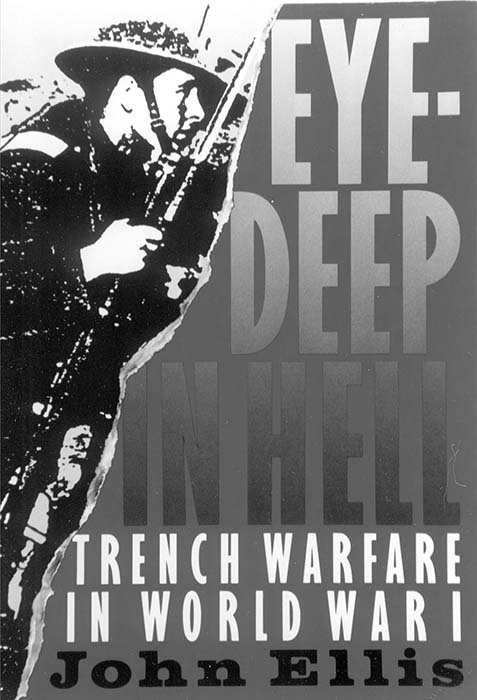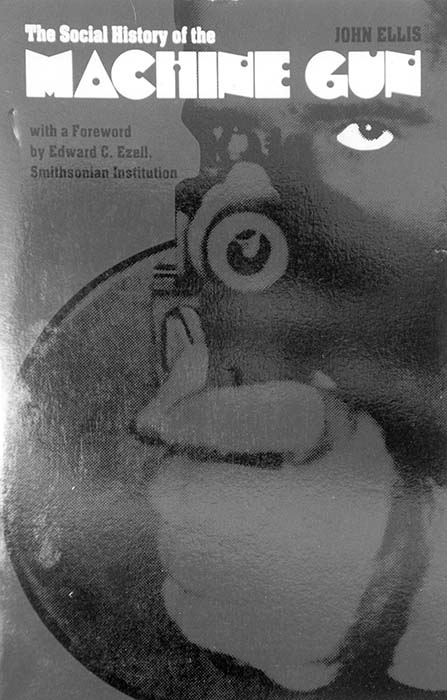By Vic Fogle
EYE DEEP IN HELL: Trench Warfare in World War I
by John Ellis
The Johns Hopkins University Press
2715 North Charles Street
Baltimore, MD 21218-4319
800-537-5487
1989 – 216 Pages
Prologue, Bibliography, Index
$16.00 Paperback
ISBN #0-8018-3947-5

This is not a gun book in the usual sense of the term. Rather, it is a description of a fortunately transitory world made by the machine gun and artillery. Focusing entirely upon World War I, this book supplements Ellis’ The Social History of the Machine Gun, which dealt in large part with the adversaries’ difficulty in adapting to defensively employed machine guns. Ellis’ assessment is that the Western Front was an unparalleled nightmare of filth, decay, noise, blood and death, in which men fought for reasons they hardly understood for a future they almost ceased to believe in, and which offered nothing when it came.
At the outset both the Central Powers and the Allies foresaw a war of movement, but French reliance upon elan and the bayonet proved no match for German Maxims. Yet the French had enough firepower to stall the German advance and, after several engagements followed the Battle of the Marne, the lines began to coagulate, all the way from the North Sea to the Swiss frontier. Because the Germans decided first that they would dig in and hold the ground they had won, they chose the high ground and most defensible points, obliging the Allies to set up defenses on the most indefensible ground, often with poor drainage and a high water table.
It is Ellis’ belief that “though artillery causes a great many casualties throughout the war, when advancing against enemy trenches it was the machine gun bullet that was likely to fell a man. It is no exaggeration to say that they completely dominated the actual battlefield.”
Most combat veterans wonder how their wars compare to other wars. Ellis provides a wealth of information on just what trench warfare was like, often in graphic detail. Consider mud – he states that the worst aspect of the mud was that men drowned in it. When they found impassable communications trenches and were forced to travel on top of the ground, they could fall into a shell hole and be sucked down. A soldier at the Third Battle of Ypres described:
“A khaki-clad leg, three heads in a row, the rest of the bodies submerged, giving one the idea that they had used their last ounce of strength to keep their heads above the rising water. In another miniature pond, a hand still gripping a rifle is all that is visible while its next-door neighbor is occupied by a steel helmet and half a head, the staring eyes staring icily at the green slime which floats on the surface almost at their level.”
There are similar descriptions of other hazards that the soldiers faced: trench foot, cold, randomly buried decomposing corpses, huge rats, flies, nits, artillery fire, poison gas, raids and patrols, infection, shell shock, inadequate and bad food and venereal disease.
Some 23% of the British troops who were wounded in December of 1915 were hit in the head, neck or face, attesting to the activity of German snipers. The latter were specially chosen and given specialized equipment, including scope sighted rifles and camouflaged capes. Moreover, unlike the British, the Germans stayed in the same sector for long periods, thereby learning the topography intimately. Usually they crawled into no man’s land at night and stayed out until the following night, moving from cover to cover after firing. Even hollow trees were used as “hides”. One British officer who took a quick look over a parapet in 1916 was hit twice by different snipers. The British did not begin really to organize their sniping organization until mid-1917.
Trench raids were organized to secure information and to maintain the offensive spirit. As the war progressed distinctive weapons evolved: rifles were shortened, truncheons and clubs were adopted, and knives came into use. Grenades were rediscovered. We can see the beginning of the specialization that produced the assault rifle, the sub-machine gun, and the small unit tactics used at Stalingrad twenty-five years later.
As the war dragged wearily on and became an isolating, alien, all-enveloping nightmare, where did the soldiers find the capacity to endure? They realized that no one who hadn’t been there could understand what they suffered, so a kind of compensatory alienation from home concerns set in. This alienation was accompanied by a heightened sense of comradeship and compassion and by pride of self and of unit. For many, too, there was a strong feeling of patriotism along with personal honor. “What most men feared was fear itself, finding themselves unable to do what was required of them.”
In addition to Ellis’ own competent exposition, he utilizes much good source material. The book is well illustrated with period photos, frequently of casualties, although photo quality leaves much to be desired. The book benefits immeasurably from the inclusion of well chosen quotations from letters home, poetry and soldiers’ descriptions of battlefield conditions. Although the author makes clear that, between military censorship and the soldiers’ desire not to worry loved ones, there was much false optimism sent home and relatively little realistic reporting during the war. Much of the source material chosen is poignant and eloquent, possibly because of the social classes that were most likely to be writing. Regrettably, Ellis does not include footnotes or endnotes to identify the sources beyond identifying the authors and should have done so.
All in all, Eye Deep In Hell presents a vivid and unforgettable record of life and death in World War I trenches and will be of interest to almost all veterans and students of war and its technology.
THE SOCIAL HISTORY OF THE MACHINE GUN
By John Ellis
The Johns Hopkins University Press
2715 North Charles Street,
Baltimore, MD 21218-4319
800-537-5487, 1896 192 Pages
Forward, illustrations, bibliography, bibliographical essay, index.
$16.00 paperback
ISBN 0-8018-3358-2

Man’s struggle to adapt his social practices and institutions to the possibilities of his technology is a popular theme in much late 20th Century writing, and nowhere is it more interestingly discussed than in John Ellis’ The Social History of the Machine Gun. It is Ellis’ thesis that “the general aspirations and prejudices of particular social groups are just as important for the history of military technology as are straightforward problems of technical efficiency. Guns, like everything else, have their social history… The anachronistic ideals of the European officer class, the messianic nature of nineteenth-century capitalism, the imperialist drive into Africa and elsewhere…were more important to the history of the machine gun than any bald assessment of its mechanical efficiency.”
After passing quickly over the technical preconditions necessary for the development of rapid firing cartridge arms, Ellis describes how the development of the industrial revolution determined that the machine gun would be invented and improved by an American. An acute shortage of labor necessitated high production per worker in order to hold prices down. Consequently, there was great incentive to utilize machines not only to make products but also to make other machines. The country had few guns and gunsmiths, so that it was relatively unarmed. These facts, combined with the absence of an organized guild of hand-workers who would feel their livelihood threatened by machine production, caused a lasting association between the machine tool industry and small arms production beginning as early as the famous Ely Whitney musket contract of 1798.
Ellis compares the reception of the machine gun by several social and occupational groups. American gangsters, beginning in the mid 1920’s, took to the Thompson sub machinegun enthusiastically and used it deep into the 1930’s. A second group, consisting of adventurers and industrialists, used machineguns to subdue natives in Africa and India, while in the U.S. they were employed, often by National Guardsmen, to threaten workers in West Virginia, Colorado and San Francisco. Yet another group that got extensive experience was the far-flung collection of junior officers, principally British and German, whose mission was instilling the blessings of western civilization among the residents of remote colonies. But because Europeans regarded colonial warfare as having little in common with “real” wars, machineguns came to be associated in the military mind with colonial adventures against strange, subhuman adversaries, so that they would have no relevance in a European war among equals.
The primary focus of the book is on the spurning of the machinegun by the European senior officer corps in the years before World War I and the painful, grudging acceptance of fully automatic weapons during the war. According to Ellis’ theme of the dichotomy between social-in this case military-institutions and technology, it was the industrial revolution, with its sweeping alterations in the way things were made and financed that surged past European armies, leaving their leaderships as an isolated, multi-national backwater. The armies were officered by that part of the landowning class bypassed by the industrial revolution, and while these officers were dimly aware that the machine had transformed much of society, they clung desperately, decade after decade to the pre-industrial belief that men controlled the battlefield and would dominate it by personal courage and heroic action directed by superior will power. The old certitude of the battlefield-that the issue would be decided by a glorious charge, pressed home by cold steel and would result in recognition of superior heroism-must not be threatened by a mere machine. Because the revolutionary firepower of the machinegun threatened to end this myth and thereby the opportunities to display material virtues, the senior officer class of the European powers attempted to ignore this new class of weapons.
Understandably, Ellis’ research has been concerned principally with the British officer class, and he tends to universalize his findings by asserting that it was the same in other countries, despite having done much less research on them.
Numerous photos and sketches enliven the book, and the many quotations add color and punch.
A former faculty member of the University of Manchester, Ellis writes smoothly and gracefully. A bonus which greatly increases the value of the work is the author’s extensive use of end notes, so that the reader can consider the author’s sources. Their presence should not disturb those who don’t read end notes, while it enhances the volume of those of us who do.
There are, regrettably, several errors that a good editor should have excised. They include reference to “William” Browning where the context indicates John, and even though he mentions the difference, Ellis persists in including Gatling and Gardiner guns, along with the mitrailleuse, as machineguns. Perhaps he should have said “rapid firing guns.”
On balance, this is a splendid volume that will be found thought provoking by everyone interested in machineguns, war and technology.
| This article first appeared in Small Arms Review V5N3 (December 2001) |











